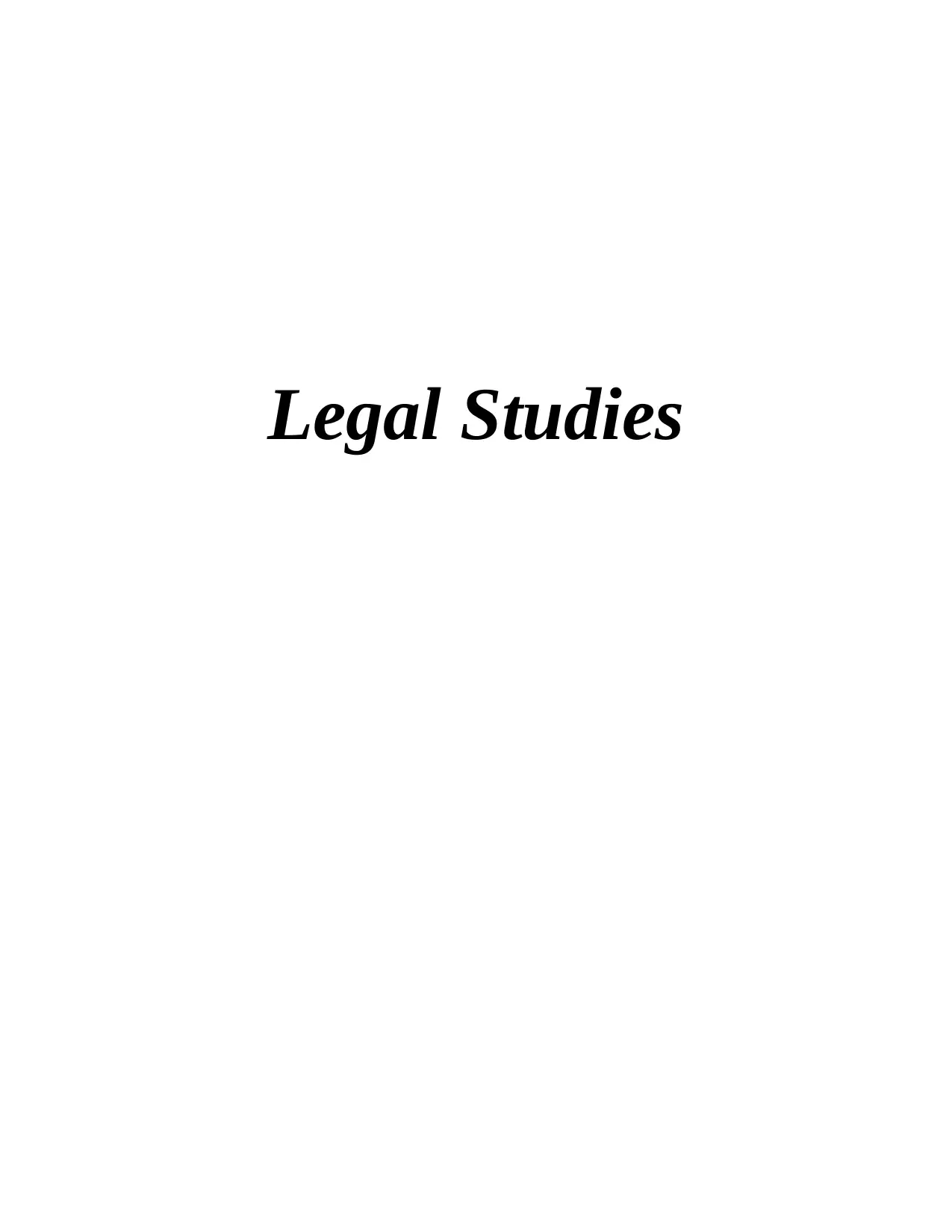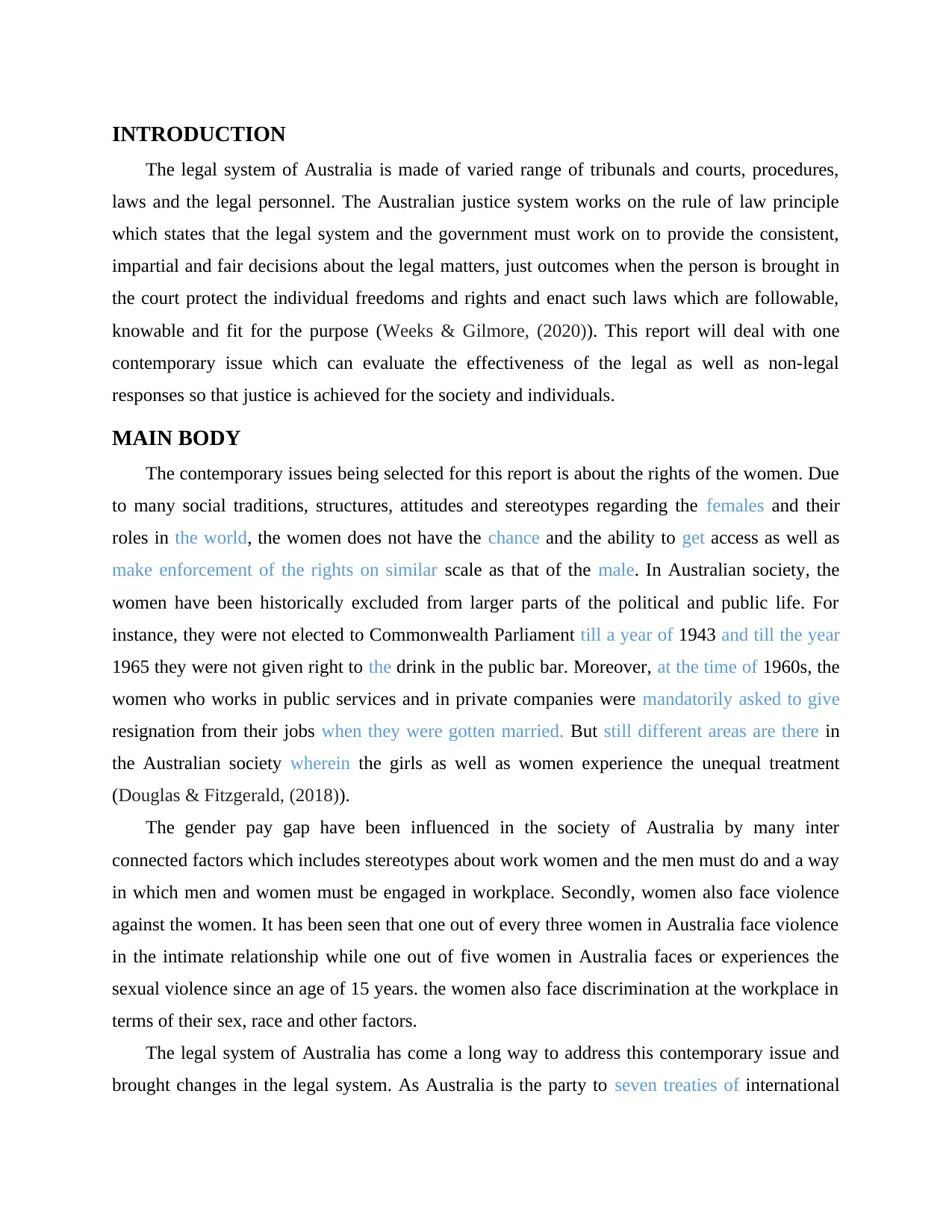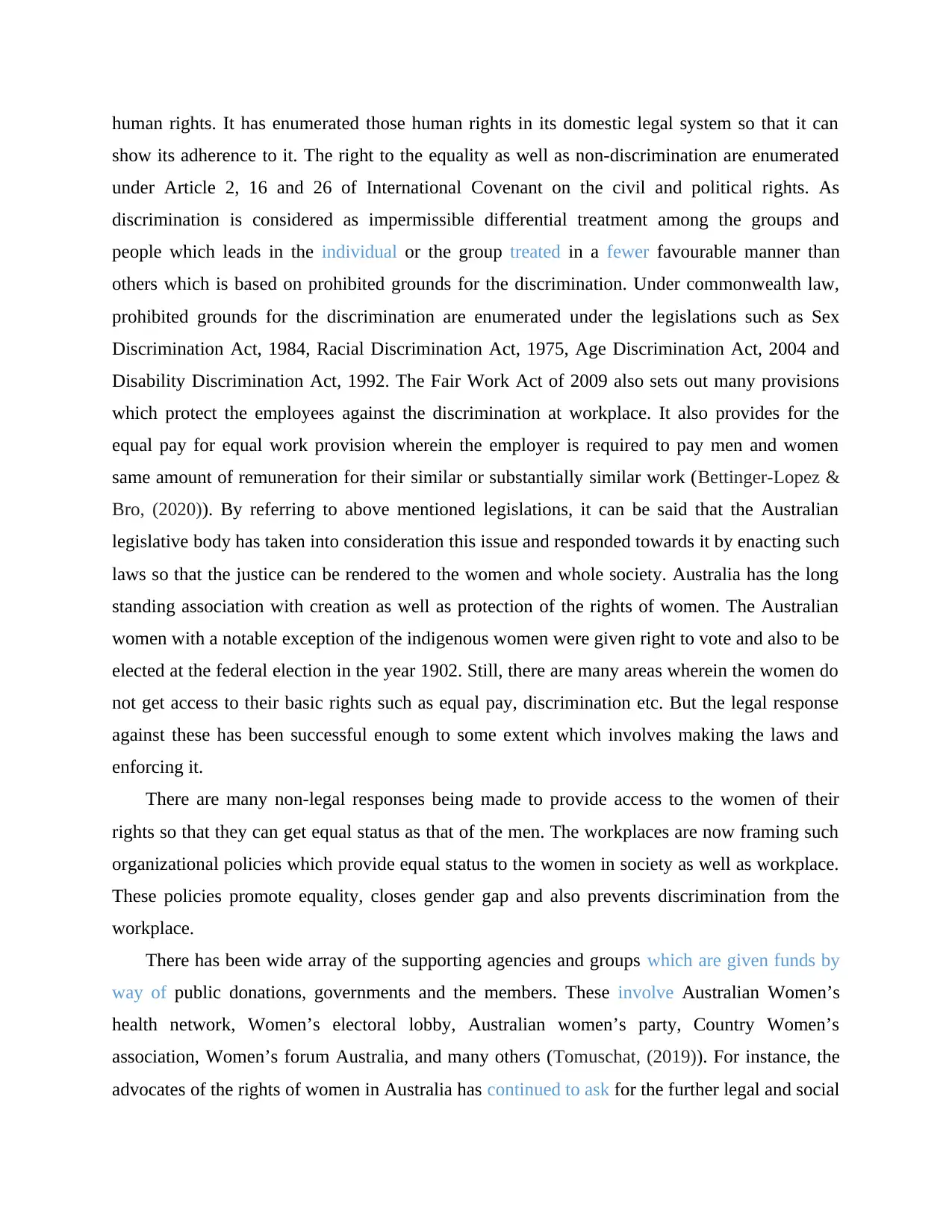Effectiveness of Responses to Women's Rights in Australia
VerifiedAdded on 2023/06/18
|7
|1493
|229
Essay
AI Summary
This essay provides an overview of the legal and non-legal responses to the issue of women's rights in Australia. It begins by introducing the Australian legal system and the principle of the rule of law. The essay then identifies the rights of women as a contemporary issue, highlighting historical and ongoing inequalities faced by women in Australian society, including the gender pay gap, violence against women, and workplace discrimination. It examines the legal responses, such as the Sex Discrimination Act, Racial Discrimination Act, Age Discrimination Act, Disability Discrimination Act, and the Fair Work Act, which aim to protect women's rights and promote equality. The essay also discusses non-legal responses, including organizational policies promoting equality and the work of various supporting agencies and groups. It concludes that both legal and non-legal responses have contributed to achieving justice for women and society in Australia.

Legal Studies
Paraphrase This Document
Need a fresh take? Get an instant paraphrase of this document with our AI Paraphraser

Contents
INTRODUCTION...........................................................................................................................3
MAIN BODY..................................................................................................................................3
CONCLUSION................................................................................................................................6
REFERENCES................................................................................................................................7
INTRODUCTION...........................................................................................................................3
MAIN BODY..................................................................................................................................3
CONCLUSION................................................................................................................................6
REFERENCES................................................................................................................................7

INTRODUCTION
The legal system of Australia is made of varied range of tribunals and courts, procedures,
laws and the legal personnel. The Australian justice system works on the rule of law principle
which states that the legal system and the government must work on to provide the consistent,
impartial and fair decisions about the legal matters, just outcomes when the person is brought in
the court protect the individual freedoms and rights and enact such laws which are followable,
knowable and fit for the purpose (Weeks & Gilmore, (2020)). This report will deal with one
contemporary issue which can evaluate the effectiveness of the legal as well as non-legal
responses so that justice is achieved for the society and individuals.
MAIN BODY
The contemporary issues being selected for this report is about the rights of the women. Due
to many social traditions, structures, attitudes and stereotypes regarding the females and their
roles in the world, the women does not have the chance and the ability to get access as well as
make enforcement of the rights on similar scale as that of the male. In Australian society, the
women have been historically excluded from larger parts of the political and public life. For
instance, they were not elected to Commonwealth Parliament till a year of 1943 and till the year
1965 they were not given right to the drink in the public bar. Moreover, at the time of 1960s, the
women who works in public services and in private companies were mandatorily asked to give
resignation from their jobs when they were gotten married. But still different areas are there in
the Australian society wherein the girls as well as women experience the unequal treatment
(Douglas & Fitzgerald, (2018)).
The gender pay gap have been influenced in the society of Australia by many inter
connected factors which includes stereotypes about work women and the men must do and a way
in which men and women must be engaged in workplace. Secondly, women also face violence
against the women. It has been seen that one out of every three women in Australia face violence
in the intimate relationship while one out of five women in Australia faces or experiences the
sexual violence since an age of 15 years. the women also face discrimination at the workplace in
terms of their sex, race and other factors.
The legal system of Australia has come a long way to address this contemporary issue and
brought changes in the legal system. As Australia is the party to seven treaties of international
The legal system of Australia is made of varied range of tribunals and courts, procedures,
laws and the legal personnel. The Australian justice system works on the rule of law principle
which states that the legal system and the government must work on to provide the consistent,
impartial and fair decisions about the legal matters, just outcomes when the person is brought in
the court protect the individual freedoms and rights and enact such laws which are followable,
knowable and fit for the purpose (Weeks & Gilmore, (2020)). This report will deal with one
contemporary issue which can evaluate the effectiveness of the legal as well as non-legal
responses so that justice is achieved for the society and individuals.
MAIN BODY
The contemporary issues being selected for this report is about the rights of the women. Due
to many social traditions, structures, attitudes and stereotypes regarding the females and their
roles in the world, the women does not have the chance and the ability to get access as well as
make enforcement of the rights on similar scale as that of the male. In Australian society, the
women have been historically excluded from larger parts of the political and public life. For
instance, they were not elected to Commonwealth Parliament till a year of 1943 and till the year
1965 they were not given right to the drink in the public bar. Moreover, at the time of 1960s, the
women who works in public services and in private companies were mandatorily asked to give
resignation from their jobs when they were gotten married. But still different areas are there in
the Australian society wherein the girls as well as women experience the unequal treatment
(Douglas & Fitzgerald, (2018)).
The gender pay gap have been influenced in the society of Australia by many inter
connected factors which includes stereotypes about work women and the men must do and a way
in which men and women must be engaged in workplace. Secondly, women also face violence
against the women. It has been seen that one out of every three women in Australia face violence
in the intimate relationship while one out of five women in Australia faces or experiences the
sexual violence since an age of 15 years. the women also face discrimination at the workplace in
terms of their sex, race and other factors.
The legal system of Australia has come a long way to address this contemporary issue and
brought changes in the legal system. As Australia is the party to seven treaties of international
⊘ This is a preview!⊘
Do you want full access?
Subscribe today to unlock all pages.

Trusted by 1+ million students worldwide

human rights. It has enumerated those human rights in its domestic legal system so that it can
show its adherence to it. The right to the equality as well as non-discrimination are enumerated
under Article 2, 16 and 26 of International Covenant on the civil and political rights. As
discrimination is considered as impermissible differential treatment among the groups and
people which leads in the individual or the group treated in a fewer favourable manner than
others which is based on prohibited grounds for the discrimination. Under commonwealth law,
prohibited grounds for the discrimination are enumerated under the legislations such as Sex
Discrimination Act, 1984, Racial Discrimination Act, 1975, Age Discrimination Act, 2004 and
Disability Discrimination Act, 1992. The Fair Work Act of 2009 also sets out many provisions
which protect the employees against the discrimination at workplace. It also provides for the
equal pay for equal work provision wherein the employer is required to pay men and women
same amount of remuneration for their similar or substantially similar work (Bettinger-Lopez &
Bro, (2020)). By referring to above mentioned legislations, it can be said that the Australian
legislative body has taken into consideration this issue and responded towards it by enacting such
laws so that the justice can be rendered to the women and whole society. Australia has the long
standing association with creation as well as protection of the rights of women. The Australian
women with a notable exception of the indigenous women were given right to vote and also to be
elected at the federal election in the year 1902. Still, there are many areas wherein the women do
not get access to their basic rights such as equal pay, discrimination etc. But the legal response
against these has been successful enough to some extent which involves making the laws and
enforcing it.
There are many non-legal responses being made to provide access to the women of their
rights so that they can get equal status as that of the men. The workplaces are now framing such
organizational policies which provide equal status to the women in society as well as workplace.
These policies promote equality, closes gender gap and also prevents discrimination from the
workplace.
There has been wide array of the supporting agencies and groups which are given funds by
way of public donations, governments and the members. These involve Australian Women’s
health network, Women’s electoral lobby, Australian women’s party, Country Women’s
association, Women’s forum Australia, and many others (Tomuschat, (2019)). For instance, the
advocates of the rights of women in Australia has continued to ask for the further legal and social
show its adherence to it. The right to the equality as well as non-discrimination are enumerated
under Article 2, 16 and 26 of International Covenant on the civil and political rights. As
discrimination is considered as impermissible differential treatment among the groups and
people which leads in the individual or the group treated in a fewer favourable manner than
others which is based on prohibited grounds for the discrimination. Under commonwealth law,
prohibited grounds for the discrimination are enumerated under the legislations such as Sex
Discrimination Act, 1984, Racial Discrimination Act, 1975, Age Discrimination Act, 2004 and
Disability Discrimination Act, 1992. The Fair Work Act of 2009 also sets out many provisions
which protect the employees against the discrimination at workplace. It also provides for the
equal pay for equal work provision wherein the employer is required to pay men and women
same amount of remuneration for their similar or substantially similar work (Bettinger-Lopez &
Bro, (2020)). By referring to above mentioned legislations, it can be said that the Australian
legislative body has taken into consideration this issue and responded towards it by enacting such
laws so that the justice can be rendered to the women and whole society. Australia has the long
standing association with creation as well as protection of the rights of women. The Australian
women with a notable exception of the indigenous women were given right to vote and also to be
elected at the federal election in the year 1902. Still, there are many areas wherein the women do
not get access to their basic rights such as equal pay, discrimination etc. But the legal response
against these has been successful enough to some extent which involves making the laws and
enforcing it.
There are many non-legal responses being made to provide access to the women of their
rights so that they can get equal status as that of the men. The workplaces are now framing such
organizational policies which provide equal status to the women in society as well as workplace.
These policies promote equality, closes gender gap and also prevents discrimination from the
workplace.
There has been wide array of the supporting agencies and groups which are given funds by
way of public donations, governments and the members. These involve Australian Women’s
health network, Women’s electoral lobby, Australian women’s party, Country Women’s
association, Women’s forum Australia, and many others (Tomuschat, (2019)). For instance, the
advocates of the rights of women in Australia has continued to ask for the further legal and social
Paraphrase This Document
Need a fresh take? Get an instant paraphrase of this document with our AI Paraphraser

reform so that gender inequality may be addressed in Australia. Although, there are some of the
areas wherein the gender equality is to be achieved yet which includes violence in contradiction
of the women is still predominant among indigenous females which involves sexual assault,
domestic violence. They also experience varies to the equal amount of participation in the public
life as the result of non-existence of legislative paid maternity scheme, discrimination, absence
of childcare for free and the sexual harassment. These has been given a voice through legal as
well as non-legal responses wherein the legislations are enacted to provide equal status to the
women as that of the men as well many groups and agencies are formed which provide their non-
legal response so that justice is rendered for the individuals (women) and society (Sassine and et.
al., (2021)). Hence, it can be said that the above mentioned responses towards the women rights
have contributed in providing justice to the women and whole society by way of commonwealth
laws and non-legal responses.
areas wherein the gender equality is to be achieved yet which includes violence in contradiction
of the women is still predominant among indigenous females which involves sexual assault,
domestic violence. They also experience varies to the equal amount of participation in the public
life as the result of non-existence of legislative paid maternity scheme, discrimination, absence
of childcare for free and the sexual harassment. These has been given a voice through legal as
well as non-legal responses wherein the legislations are enacted to provide equal status to the
women as that of the men as well many groups and agencies are formed which provide their non-
legal response so that justice is rendered for the individuals (women) and society (Sassine and et.
al., (2021)). Hence, it can be said that the above mentioned responses towards the women rights
have contributed in providing justice to the women and whole society by way of commonwealth
laws and non-legal responses.

CONCLUSION
It is concluded from this report that the legal system of Australia comprises of the laws,
regulations, courts and tribunal which are entrusted with the task to promote rights and freedom
to people and punish the lawbreakers. There is a contemporary issue in the Australia which
involves rights of women as they are not given equal status in the society as well workplace.
There are different responses being taken to tackle this issue which includes legal as well as non-
legal. The legal response includes enactment of various legislations such as Sex Discrimination
Act, Fair work Act, etc. The non-legal responses include framing of such policies which
promotes equality, various groups and agencies are formed which promotes equality and ask
government to bring such laws which can protect the rights of women.
It is concluded from this report that the legal system of Australia comprises of the laws,
regulations, courts and tribunal which are entrusted with the task to promote rights and freedom
to people and punish the lawbreakers. There is a contemporary issue in the Australia which
involves rights of women as they are not given equal status in the society as well workplace.
There are different responses being taken to tackle this issue which includes legal as well as non-
legal. The legal response includes enactment of various legislations such as Sex Discrimination
Act, Fair work Act, etc. The non-legal responses include framing of such policies which
promotes equality, various groups and agencies are formed which promotes equality and ask
government to bring such laws which can protect the rights of women.
⊘ This is a preview!⊘
Do you want full access?
Subscribe today to unlock all pages.

Trusted by 1+ million students worldwide

REFERENCES
Books and Journals
Bettinger-Lopez, C., & Bro, A. (2020). A double pandemic: Domestic violence in the age of
COVID-19. Council on Foreign Relations. 13.
Douglas, H., & Fitzgerald, R. (2018). The domestic violence protection order system as entry to
the criminal justice system for Aboriginal and Torres Strait Islander
people. International Journal for Crime, Justice and Social Democracy. 7(3). 41.
Sassine, H., and et. al., (2021). Why do women choose homebirth in Australia? A national
survey. Women and Birth. 34(4). 396-404.
Tomuschat, C. (2019). Equality and non-discrimination under the International Covenant on
Civil and Political Rights (pp. 691-716). De Gruyter.
Weeks, W., & Gilmore, K. (2020). How violence against women became an issue on the
national policy agenda. In Making social policy in Australia (pp. 141-153). Routledge.
Books and Journals
Bettinger-Lopez, C., & Bro, A. (2020). A double pandemic: Domestic violence in the age of
COVID-19. Council on Foreign Relations. 13.
Douglas, H., & Fitzgerald, R. (2018). The domestic violence protection order system as entry to
the criminal justice system for Aboriginal and Torres Strait Islander
people. International Journal for Crime, Justice and Social Democracy. 7(3). 41.
Sassine, H., and et. al., (2021). Why do women choose homebirth in Australia? A national
survey. Women and Birth. 34(4). 396-404.
Tomuschat, C. (2019). Equality and non-discrimination under the International Covenant on
Civil and Political Rights (pp. 691-716). De Gruyter.
Weeks, W., & Gilmore, K. (2020). How violence against women became an issue on the
national policy agenda. In Making social policy in Australia (pp. 141-153). Routledge.
1 out of 7
Related Documents
Your All-in-One AI-Powered Toolkit for Academic Success.
+13062052269
info@desklib.com
Available 24*7 on WhatsApp / Email
![[object Object]](/_next/static/media/star-bottom.7253800d.svg)
Unlock your academic potential
Copyright © 2020–2025 A2Z Services. All Rights Reserved. Developed and managed by ZUCOL.





